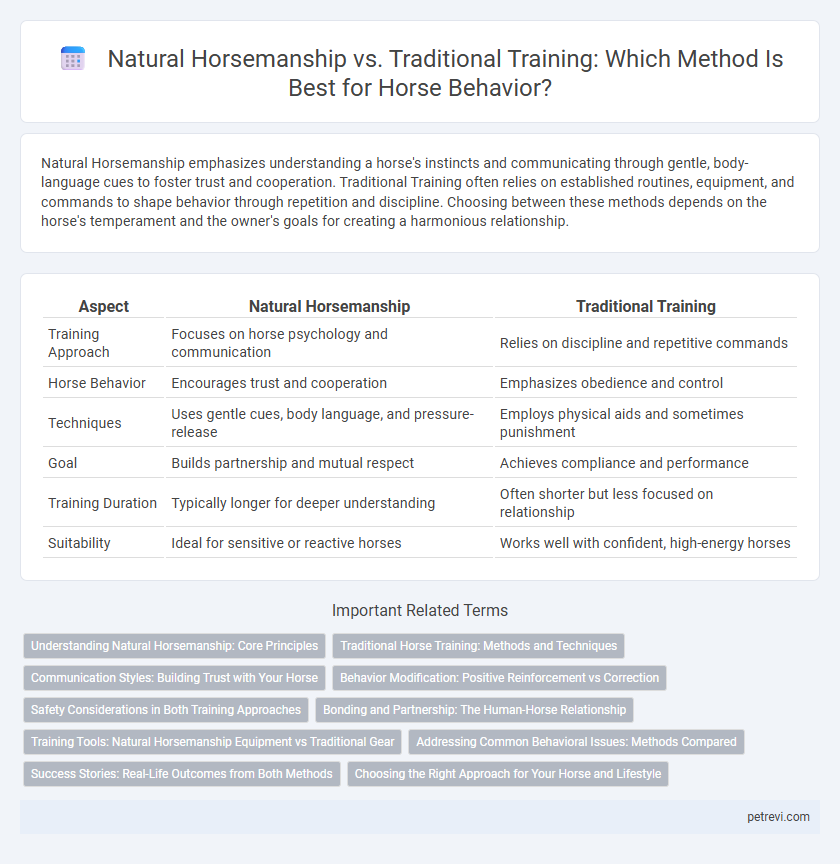Natural Horsemanship emphasizes understanding a horse's instincts and communicating through gentle, body-language cues to foster trust and cooperation. Traditional Training often relies on established routines, equipment, and commands to shape behavior through repetition and discipline. Choosing between these methods depends on the horse's temperament and the owner's goals for creating a harmonious relationship.
Table of Comparison
| Aspect | Natural Horsemanship | Traditional Training |
|---|---|---|
| Training Approach | Focuses on horse psychology and communication | Relies on discipline and repetitive commands |
| Horse Behavior | Encourages trust and cooperation | Emphasizes obedience and control |
| Techniques | Uses gentle cues, body language, and pressure-release | Employs physical aids and sometimes punishment |
| Goal | Builds partnership and mutual respect | Achieves compliance and performance |
| Training Duration | Typically longer for deeper understanding | Often shorter but less focused on relationship |
| Suitability | Ideal for sensitive or reactive horses | Works well with confident, high-energy horses |
Understanding Natural Horsemanship: Core Principles
Natural Horsemanship emphasizes communication through body language, respect, and empathy, fostering a partnership rather than dominance between human and horse. Key principles include observation of equine behavior, establishing trust, and using non-coercive techniques to encourage voluntary cooperation. This approach contrasts with Traditional Training's reliance on control and repetitive commands, promoting a deeper understanding of horse psychology and emotional needs.
Traditional Horse Training: Methods and Techniques
Traditional horse training relies on established methods such as pressure and release, consistent routines, and operant conditioning to shape horse behavior. Techniques often include groundwork exercises, lunging, and riding to develop control and responsiveness, emphasizing discipline and rider authority. This approach prioritizes structured learning and clear communication between horse and trainer to achieve predictable performance outcomes.
Communication Styles: Building Trust with Your Horse
Natural horsemanship emphasizes gentle communication through body language and emotional connection, fostering mutual trust and respect between horse and trainer. Traditional training often relies on direct commands and discipline, which may prioritize control over relationship-building. Prioritizing empathetic interaction in natural horsemanship leads to enhanced cooperation and reduced stress responses in horses.
Behavior Modification: Positive Reinforcement vs Correction
Natural horsemanship emphasizes behavior modification through positive reinforcement, utilizing rewards such as treats and praise to encourage desired responses, fostering a trusting and cooperative relationship between horse and trainer. Traditional training often relies on correction-based methods, including pressure and punishment, to suppress unwanted behaviors but may risk creating fear or resistance in the horse. Studies show that positive reinforcement enhances learning retention and reduces stress, making it a more effective and humane approach for long-term behavioral changes.
Safety Considerations in Both Training Approaches
Natural Horsemanship emphasizes building trust and communication through non-violent methods, reducing the risk of stress-induced injuries for both horse and handler. Traditional training often relies on established techniques that may involve physical correction, which can increase the likelihood of reactive behaviors and accidents. Prioritizing safety, natural horsemanship typically promotes patience and understanding, fostering safer environments compared to some conventional practices.
Bonding and Partnership: The Human-Horse Relationship
Natural Horsemanship emphasizes building trust and mutual respect through gentle communication, promoting a deep bond and partnership between human and horse. Traditional training often relies on repetition and dominance, which can create compliance but may limit emotional connection. Prioritizing empathy and understanding in Natural Horsemanship fosters cooperation and enhances the horse's willingness to engage, resulting in a stronger, more harmonious relationship.
Training Tools: Natural Horsemanship Equipment vs Traditional Gear
Natural horsemanship training utilizes gentle tools such as rope halters, longe lines, and body language cues that emphasize communication and trust between horse and trainer. Traditional training relies heavily on equipment like metal bits, heavy bridles, and spurs, designed to exert control and correction. Choosing natural horsemanship equipment promotes a more humane approach and enhances horse responsiveness without causing discomfort or resistance.
Addressing Common Behavioral Issues: Methods Compared
Natural horsemanship emphasizes communication and empathy, using body language and gentle cues to address common behavioral issues such as anxiety, resistance, and aggression. Traditional training often relies on repetition, physical control, and established routines to correct behaviors like rearing, bolting, or nipping. Studies indicate natural horsemanship can increase trust and reduce stress, while traditional methods may achieve faster compliance but sometimes risk creating fear or confusion in horses.
Success Stories: Real-Life Outcomes from Both Methods
Natural Horsemanship has produced numerous success stories where horses display improved trust and responsiveness through patience and communication-based techniques. Traditional training methods often yield quick behavioral results by emphasizing discipline and consistent routines, making them effective for performance-driven goals. Both approaches showcase real-life outcomes that highlight their unique strengths in shaping horse behavior and enhancing rider-horse relationships.
Choosing the Right Approach for Your Horse and Lifestyle
Natural Horsemanship emphasizes gentle communication and understanding equine psychology, fostering trust and cooperation through non-coercive methods tailored to the horse's natural instincts. Traditional Training often relies on established routines and discipline-based techniques that prioritize obedience and consistency, which can be effective for specific riding disciplines or competitive environments. Selecting the right approach depends on your horse's temperament, your riding goals, and lifestyle demands, ensuring harmony and safety in your partnership.
Natural Horsemanship vs Traditional Training for Horse Behavior Infographic

 petrevi.com
petrevi.com